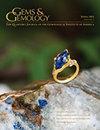世界上最大钻石的深层起源
IF 1.6
3区 地球科学
Q2 MINERALOGY
引用次数: 27
摘要
用于珠宝的宝石是地球深处最具科学价值的样品之一。对其包含的矿物和结晶历史的解释提供了100多公里地下无法进入的地质过程的快照,通常是过去数十亿年的地质过程(例如,Shirey和Shigley,2013)。没有其他矿物样本能够提供如此深度和很久以前的研究信息。直到最近,像著名的库里南或莱索托承诺这样的特殊宝石钻石,具有一系列将其与其他种类钻石区分开来的物理特征,仍然是神秘的,来源不明(Bowen等人,2009;格尼和赫尔姆斯特德,2012年;摩尔,2014年)。它们是如何形成的?当然不像99%的其他宝石钻石。GIA、卡内基科学研究所和帕多瓦大学在过去两年中进行的新研究表明,这些类似库利南的钻石以一种地质上特殊的方式形成,涉及金属液体,起源于地幔中远低于其他宝石钻石的极端深度(Smith et al.,2016)。本文章由计算机程序翻译,如有差异,请以英文原文为准。
The Very Deep Origin of the World's Biggest Diamonds
gemstones for jewelry, are some of the most scientifically valuable samples of the deep earth. Interpretation of their included minerals and crystallization history provides a snapshot of otherwise inaccessible geological processes from more than 100 kilometers underground and often from billions of years in the past (e.g., Shirey and Shigley, 2013). No other mineral sample can provide information for research from such depths and from so long ago. Until recently, exceptional gem diamonds such as the famous Cullinan or Lesotho Promise, with a set of physical characteristics that distinguish them from other kinds of diamonds, were enigmatic and had an unknown origin (Bowen et al., 2009; Gurney and Helmstaedt, 2012; Moore, 2014). How did they form? Certainly not like 99% of other gem diamonds. New research carried out in the last two years at GIA, the Carnegie Institution for Science, and the University of Padua reveals that these Cullinan-like diamonds form in a geologically special way, involving metallic liquid and originating from extreme depths in Earth’s mantle well below that of other gem diamonds (Smith et al., 2016).
求助全文
通过发布文献求助,成功后即可免费获取论文全文。
去求助
来源期刊

Gems & Gemology
地学-矿物学
CiteScore
2.90
自引率
19.20%
发文量
10
期刊介绍:
G&G publishes original articles on gem materials and research in gemology and related fields. Manuscript topics include, but are not limited to:
Laboratory or field research;
Comprehensive reviews of important topics in the field;
Synthetics, imitations, and treatments;
Trade issues;
Recent discoveries or developments in gemology and related fields (e.g., new instruments or identification techniques, gem minerals for the collector, and lapidary techniques);
Descriptions of notable gem materials and localities;
Jewelry manufacturing arts, historical jewelry, and museum exhibits.
 求助内容:
求助内容: 应助结果提醒方式:
应助结果提醒方式:


